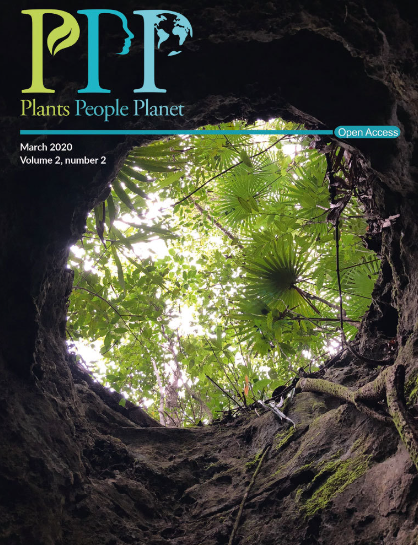Exploring the role of mobile genetic elements in shaping plant–bacterial interactions for sustainable agriculture and ecosystem health
IF 3.6
2区 环境科学与生态学
Q1 BIODIVERSITY CONSERVATION
引用次数: 0
Abstract
Societal Impact Statement Plants and bacteria interact in complex ways that are crucial to the health and productivity of native vegetation and croplands. While the range of characterised plant‐beneficial bacterial traits continues to grow, key questions remain regarding the distribution and mobility of genes associated with these traits. This work explores the diversity of mobile genetic elements carried by bacteria associated with plant root surfaces, assessing their capacity to help shape plant–bacterial interactions. The significance of this work lies in the potential to contribute to new strategies for enhancing plant health, promoting sustainable agriculture and managing plant diseases in an era when we must respond to environmental change. Summary Integrons are gene capture and expression systems that contribute to bacterial adaptation. Integron research has mainly focused on the role that these elements play in spreading antimicrobial resistance. However, their contribution to niche adaptation is potentially much broader because integrons can sample the vast repertoire of diverse functions encoded by integron gene cassettes. Integrons and gene cassettes have been identified in many bacterial lineages residing in soil and water across varied ecosystems, but there has been little investigation of integrons in plant‐associated bacteria. Bacteria and plants have complex, dynamic relationships that influence plant health and productivity. To investigate whether integrons contribute to adaptative processes in plant microbiomes, we examined gene cassette and microbial taxonomic profiles in rhizoplanes of four important crop species grown under controlled glasshouse conditions. We identified 38,546 unique gene cassettes, including elements carrying genes associated with antibiotic resistance, type II toxin–antitoxin systems and genes with putative functions associated with plant growth promotion, along with a larger set encoding genes of unknown functions. Rhizoplane microbiomes of different plant species showed more similarity in their community composition profiles than in their gene cassette profiles, with complex and distinct suites of gene cassettes associated with each plant species, suggesting that gene cassettes might have a role in specific plant–bacterial interactions. We show that rhizoplane microbiomes carry diverse integron gene cassettes that could play a role in establishing and maintaining rhizoplane communities.探索移动遗传元素在塑造可持续农业和生态系统健康的植物-细菌相互作用中的作用
植物和细菌以复杂的方式相互作用,对原生植被和农田的健康和生产力至关重要。虽然植物有益细菌特征的范围不断扩大,但与这些特征相关的基因的分布和移动性仍然存在关键问题。这项工作探索了与植物根表面相关的细菌携带的可移动遗传元件的多样性,评估了它们帮助形成植物-细菌相互作用的能力。这项工作的重要意义在于,在我们必须应对环境变化的时代,有可能有助于制定加强植物健康、促进可持续农业和管理植物病害的新战略。整合子是促进细菌适应的基因捕获和表达系统。整合子的研究主要集中在这些元素在传播抗菌素耐药性中所起的作用。然而,它们对生态位适应的贡献可能要广泛得多,因为整合子可以对整合子基因盒编码的大量不同功能进行采样。整合子和基因盒已经在不同生态系统的土壤和水中的许多细菌谱系中被发现,但对植物相关细菌中的整合子的研究很少。细菌和植物有着复杂的、动态的关系,影响着植物的健康和生产力。为了研究整合子是否有助于植物微生物组的适应性过程,我们研究了在受控温室条件下生长的四种重要作物根际的基因盒和微生物分类图谱。我们确定了38546个独特的基因盒,包括携带与抗生素抗性相关的基因的元件,II型毒素-抗毒素系统和与植物生长促进有关的假定功能的基因,以及一组未知功能的编码基因。不同植物根际微生物群落组成谱的相似性大于基因盒谱的相似性,每种植物根际微生物群落都有复杂而独特的基因盒,这表明基因盒可能在特定的植物-细菌相互作用中起作用。我们发现根际微生物组携带多种整合子基因盒,可以在建立和维持根际群落中发挥作用。
本文章由计算机程序翻译,如有差异,请以英文原文为准。
求助全文
约1分钟内获得全文
求助全文
来源期刊

Plants People Planet
Multiple-
CiteScore
9.90
自引率
5.90%
发文量
81
审稿时长
12 weeks
期刊介绍:
Plants, People, Planet aims to publish outstanding research across the plant sciences, placing it firmly within the context of its wider relevance to people, society and the planet. We encourage scientists to consider carefully the potential impact of their research on people’s daily lives, on society, and on the world in which we live. We welcome submissions from all areas of plant sciences, from ecosystem studies to molecular genetics, and particularly encourage interdisciplinary studies, for instance within the social and medical sciences and chemistry and engineering.
 求助内容:
求助内容: 应助结果提醒方式:
应助结果提醒方式:


